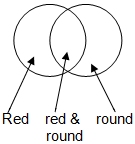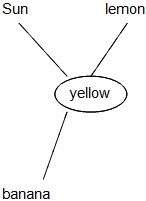User login
 use adjectives to describe and classify objects
use adjectives to describe and classify objects 
Description:
The child will understand and use a variety of adjectives.
| Early years skill: | not specified |
| Early years typical range: | not specified |
| P-scales/Curriculum skill: | Materials and Their Properties |
| P-scales/Curriculum level: | L2 |
| TAP skill: | Expressive Language |
| TAP level: | TAP72 |
| Pre/Nat. Curriculum Area: | not specified |
| Pre/Nat. Curiculum Standard: | not specified |
| Section: | Primary (5-11yrs) info |
| Activity/strategy name and materials required | How to do the activity | Key principles for doing the activity and comments |
|---|---|---|
| Classify the object 1
| 1. Decide on a common category e.g. "things which are round" or "things which are red". 2. Help the child to sort the items into 2 groups according to whether they fit the category or not (i.e. a 'red' group and a 'not red' group). | |
| Classify the object 2 A selection of common objects (you could use pictures instead) 2 sorting rings (draw two overlapping circles on a large sheet of paper if these are not available)
Category labels (optional) | 1. Decide on two common categories e.g. "things which are round" and "things which are red". 2. Place the sorting rings on the table so that they overlap. 3. Explain that one ring is for items that have one feature (e.g. "round"). Explain that the other ring is for items that have the other feature (e.g. "red"). Explain that where the rings overlap, is where things that have both features go (see diagram on the left). Items which do not fit either category are left outside the rings. 4. Add labels if you are using them. 5. Help the child to sort the items into groups according to which category they fit. | To make this activity more difficult, you could sort according to three categories. |
| Spider chart
| Example of a spider chart:
| |
| What's in the bag?
| ||
| Nicknames No materials required | Works well as a group activity - could be used as an ice-breaker. | |
| I spy adjectives No materials required. | ||
| Books
|
Support Commtap to keep it online
Thank you for visiting Commtap.
Please read this message as it is extremely important.
- Visitor donations mean we can continue to host over 1,000 free activities to support speech, language, and communication development.
- Visitor donations mean we can continue to provide free resources to address a wide range of communication needs, including limited speech or language, interaction challenges, and needs associated with conditions such as developmental language disorder, autism, and cerebral palsy.
- Visitor donations mean we can continue to provide resources to support the work of speech and language therapists, teachers, teaching assistants, parents, and carers.
- Visitor donations mean we can continue to provide the free key word sign dictionary (bks.org.uk) which has over 2,000 Makaton and Signalong signs.
We know that not everyone is able to afford to pay to access these resources, however, if you can, please make a donation to keep the site going.
Thank you
Google ads on this page are provided by Google Adsense - and their presence does not imply any endorsement by Commtap. Report a problem with an ad on this page. Log in (for free) to avoid seeing Google ads.


